Who Controls the User Experience? AMD’s Carrizo Thoroughly Tested
by Ian Cutress on February 4, 2016 8:00 AM ESTGaming Benchmarks: 3DMark and Rocket League
Due to timing we were only able to run a couple of gaming tests, namely parts of the 3DMark suite and our Rocket League test. A reminder of our systems, including their graphics:
| System Overview | ||||
| µArch | APU + GPU | Memory | Channel | |
| HP Elitebook 745 G2 | Kaveri | A10 PRO-7350B (19W) R6, 384 SPs, 533 MHz |
8 GB | Dual |
| HP Elitebook 745 G3 | Carrizo | PRO A12-8800B (15W) R7, 512 SPs, 800 MHz |
4 GB | Single |
| Toshiba Satellite E45DW-C4210 |
Carrizo | FX-8800P (15W) R7, 512 SPs, 800 MHz |
8 GB | Single |
| HP Pavilion 17z-g100 |
Carrizo | A10-8700P (15W) R6, 384 SPs, 800 MHz |
8 GB | Single |
| Lenovo Y700 | Carrizo | FX-8800P (15W) R7, 512 SPs, 800 MHz R9 385MX, 512 SPs, 900-100 MHz |
16 GB | Single |
One of the biggest issues we’ll see here is the effect of dual channel memory on gaming. The Kaveri system used has a chipset solution that supports dual graphics, but also two memory modules installed. The Carrizo systems either came pre-prepared with one module installed or do not support dual channel memory full stop. This latter point is the main kick in the teeth, especially for a company like AMD that prides itself on gaming – the issue here is down to pin compatibility between Carrizo and Carrizo-L. As the latter only supports single channel, an OEM will design one motherboard to support both platforms (whether they are used for both or not). If a motherboard supports Carrizo-L, then it will not ever support dual channel memory, and any Carrizo APU that is used will be crippled.
Technically the Lenovo Y700 gets around this (hands up if you ever see a Carrizo-L based Y700 please) by equipping the system with a discrete graphics card and disabling Crossfire, so this system will still ultimately win in our tests due to the discrete card. The downside of this augmentation is the higher power draw, which would matter if our Y700 sample had a battery (the retail units come with a 60 Wh battery).
3DMark
3DMark is Futuremark's premium software, developed to tax systems at various different performance levels. The software contains several benchmarks as a result, with some focusing more on smartphone use all the way up to 4K, quad-SLI systems with as many in-game and post processing effects as you can throw at it. The base test, Ice Storm, is actually a good indicator of GPU scaling performance, but we also test Cloud Gate, Sky Diver and Fire Strike to get a measure of all of our systems.
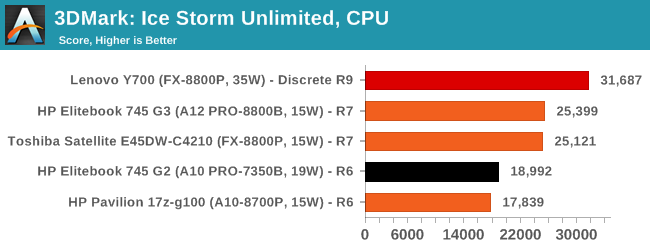
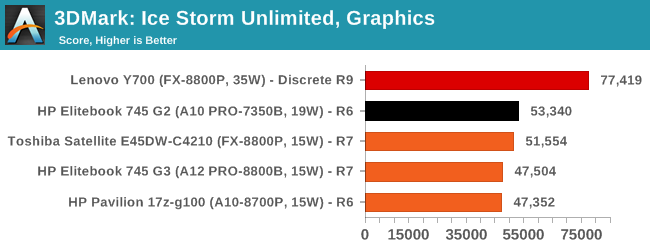
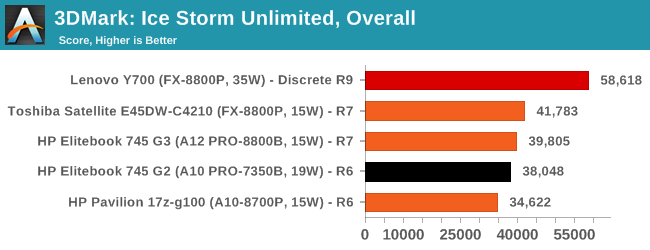
The easiest test, Ice Storm, shows the performance benefits of the Carrizo APUs in the CPU stage, although the dual channel memory for the Kaveri kicks in and gives it the graphics lead. The overall scores however benefit from that high CPU boost, so Carrizo at 15W on single channel wins this round.

Moving up in difficulty to Cloud Gate puts dual channel Kaveri in the lead, although the Toshiba is holding on a bit with its higher thermal skin temperature limit.
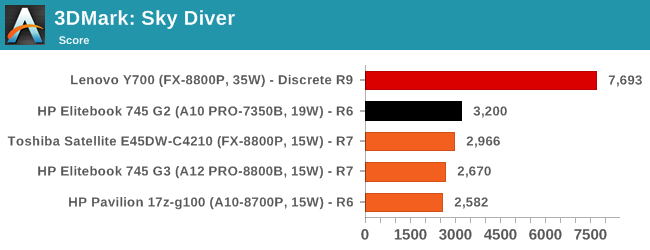
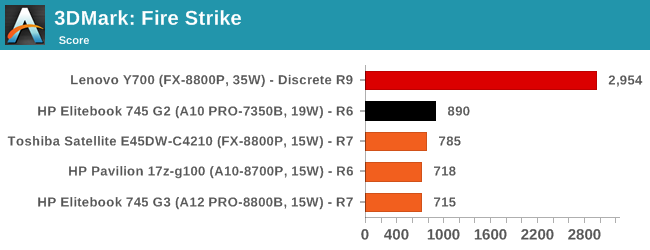
The last two benchmarks fall square with the dual channel configuration. The GDDR5 of the discrete graphics card in the Y700 wins out on all of them.
Rocket League
Hilariously simple pick-up-and-play games are great fun. I'm a massive fan of the Katamari franchise for that reason — passing start on a controller and rolling around, picking up things to get bigger, is extremely simple. Until we get a PC version of Katamari that I can benchmark, we'll focus on Rocket League. Rocket League combines the elements of pick-up-and-play, allowing users to jump into a game with other people (or bots) to play football with cars with zero rules. The title is built on Unreal Engine 3 and it allows users to run the game on super-low-end systems while still taxing the big ones. Since the release earlier in 2015, it has sold over 5 million copies and seems to be a fixture at LANs and game shows.
With Rocket League, there is no benchmark mode, so we have to perform a series of automated actions. We take the following approach: Using Fraps to record the time taken to show each frame (and the overall frame rates), we use an automation tool to set up a consistent 4v4 bot match on easy, with the system applying a series of inputs throughout the run, such as switching camera angles and driving around. It turns out that this method is nicely indicative of a real bot match, driving up walls, boosting and even putting in the odd assist, save and/or goal, as weird as that sounds for an automated set of commands. To maintain consistency, the commands we apply are not random but time-fixed, and we also keep the map the same (Denham Park) and the car customization constant. We start recording just after a match starts, and record for 4 minutes of game time, with average frame rates, 99th percentile and frame times all provided. For these tests, we used the 1280x720 resolution at high settings. A bigger explanation of testing can be seen in our AMD A8-7670K APU review.

Built on UE3 and DX9, the game relies heavily on single threaded performance and at this level of detail, memory bandwidth. The Kaveri takes the crown, showing that at this level adding another stick of memory (and making sure you have the right configuration) is more important than a more advanced (or perhaps expensive) APU.
We’ll go into temperatures on the next page.















175 Comments
View All Comments
jabber - Friday, February 5, 2016 - link
You'd think someone was paying the OEMs to hamstring these machines...Some odd facepalm design decisions there.
CajunArson - Friday, February 5, 2016 - link
Somebody *IS* paying OEMs to hamstring the machines: Customers. Customers who want cheap products that is.AMD makes its reputation as: "Intel is too expensive! We're cheap!" Don't act all shocked and surprised when the rest of the components in the system end up being the cheap components too.
As Anand just pointed out with that price comparison, even with all the cheaping out you can still see a whopping $8 price advantage for AMD on comparably configured notebooks.
tipoo - Friday, February 5, 2016 - link
Seriously, some weird stuff. No dual graphics when the chips are almost the same performance? Single channel RAM? What the hell.Midwayman - Friday, February 5, 2016 - link
I feel like AMD needs to pull a MS surface or Nexus and put out a reference model to show OEMs how it is supposed to be done. If all OEMs will do is put out a half assed effort, at least then they can just copy the reference design and it will work well.bojblaz - Friday, February 5, 2016 - link
+1... You're right, OEMs have pissed off MS and Google enough for them to go solo. AMD could totally follow suitInquisitorDavid - Friday, February 5, 2016 - link
Sure, if they had the money to. As it stands, the company is now banking on Zen to rescue them. I don't think they can afford to invest in going solo with device designs, at least not right now.TheinsanegamerN - Thursday, February 11, 2016 - link
They could team up with the likes of MSI or Clevo. Both have done good AMD laptops in the past.A 14 inch msi laptop with a 100wh battery, a 8800p, and 8gb dual channel ram would fetch a good price from those who want AMD laptops.
0razor1 - Friday, February 5, 2016 - link
Attn Ed: The HP Elitebook 745 G2GCN 1.0 in the text and then 1.1 in the grid.
Nice read BTW.
Ian Cutress - Friday, February 5, 2016 - link
Fixed! Thanks :)RationalHaterade - Friday, February 5, 2016 - link
Great write-up, Ian. This is enlightening, and the buoyant attitude at AMD might be saying a lot about what we can expect to see from the 2016/17 product releases.Speaking to Carrizo, I'm not sure they realized how badly they were hurting themselves when they elected to keep Kabini/Temash as single-channel designs and then provide OEMs a cheap out by making it pin-compatible with the big architecture. GCN has always been very bandwidth-dependent in every APU they've released. These single-channel setups have got to be really starving the SoC.
Either way, the performance picture points out what everyone already knows. Zen can't get to mobile quickly enough.